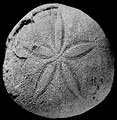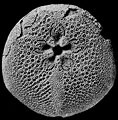The Echinoid Directory
Lefortia Cossmann, 1901, p. 58
[Clarkiella Lambert, 1916, p. 169, type species Cassidulus hemisphericus Slocum, 1909, =Cassidulus conoideus Clark in Clark Twitchell, 1915; =Pomelia de Loriol, 1900, p. 66, non Zittel, 1878; = Pomeliopsis de Loriol, 1901, p. 45 (objective) ]
| Diagnostic Features |
|
|---|---|
| Distribution | Upper Cretaceous (Senonian-Maastrichtian) of Europe, Madagascar and USA. |
| Name gender | feminine |
| Type | Pomelia delgadoi de Loriol, 1900, p. 67; by monotypy. |
| Species Included |
|
| Classification and/or Status | Irregularia; Cassiduloida; Faujasiidae; Faujasiinae. |
| Remarks |
|




